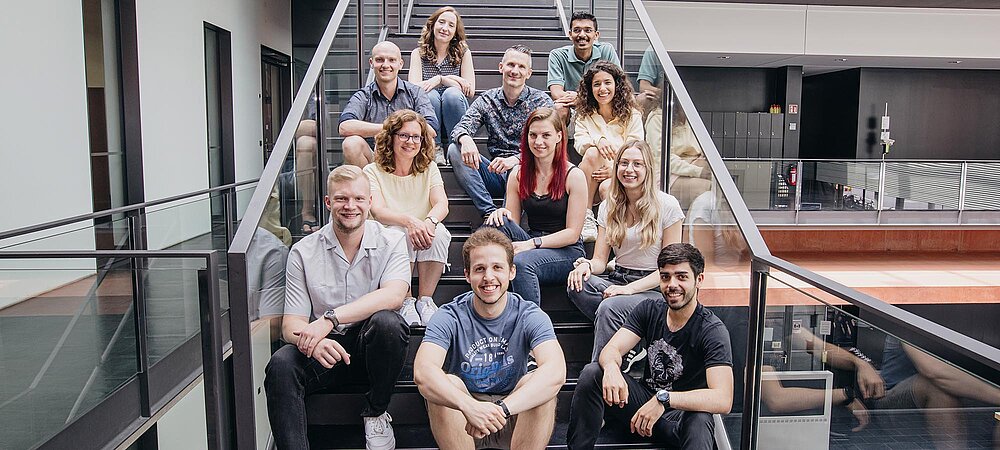Maric Group
Vision
The molecular interactions of proteins and RNA define the logic of life and disease, but remain largely uncharted. Our research centers on the rational decoding and pharmacological targeting of disease-relevant protein and RNA interactions, with a particular focus on noncanonical binding interfaces that are difficult to target using conventional small molecules. We employ high-throughput synthetic chemistry, miniaturized screening, and molecular imaging to uncover and modulate the molecular mechanisms that drive cancer, infection, autoimmune disease, and neurodegeneration.
Targeting protein-protein interactions
One focus of our lab is the targeting of protein–protein interactions. Developed binders include cellular active viral capsid aggregators as well as Sylites, first examples of synthetic probes for high-end microscopy that outperform conventional antibodies in labelling efficiency and resolution.
Huhn & Ho JACS 2025 https://doi.org/10.1021/jacs.5c00772
Khayenko & Makbul eLife 2025 https://doi.org/10.7554/eLife.98827.2
Khayenko Angewandte Chemie 2022 https://doi.org/10.1002/anie.202202078
Targeting mRNA
We are characterizing RNA–protein interactions and developing programmable PNA-based molecules that target mRNA, allowing precise modulation of gene expression. We have recently demonstrated the selective inhibition of gene expression through high-throughput screening of specific mRNA-targeting synthetic binders.
Danti & Popella Advanced Science 2025 https://doi.org/10.1002/advs.202504284
Autoantibodies and therapeutic antibodies
We study autoantibodies and therapeutic antibodies in microarray format at unprecedented throughput. Using microliter amounts of patient sera, we have identified novel disease-specific epitopes and evaluated their neutralization potential. In addition, we have comprehensively characterized therapeutic antibodies beyond the epitope level. Our laboratory applies identified epitopes for epitope-guided antibody discovery and the development of targeted neutralization strategies.
Talucci biorxiv 2025 https://doi.org/10.1101/2025.02.26.640323
Talucci Trends in Pharmacological Sciences 2024 https://doi.org/10.1016/j.tips.2024.07.007
Talucci Front Immun 2024 https://doi.org/10.3389/fimmu.2024.1329013
mariclab
Google Scholar: https://scholar.google.com/citations?user=BuL6P2AAAAAJ&hl=de
1. Danti G, Popella L, Vogel J, Maric HM; High-Throughput Tiling of Essential mRNAs Increases Potency of Antisense Antibiotics; Advanced Science, just accepted (2025).
2. Huhn C, Ho S-Y, Schulte C, Khayenko V, Hemmen K, Peulen T-O, Wiessler A-L, Bothe S, Bej A, Talucci I, Schönemann L, Werner C, Schindelin H, Strømgaard K, Villmann C, Heinze KG, Hruska M, Hell JW, Maric HM; eSylites: Synthetic Probes for Visualization and Topographic Mapping of Single Excitatory Synapses; J. Am. Chem. Soc., Article ASAP (2025). DOI: 10.1021/jacs.5c00772.
3. Talucci I, Leske T, Klafki H-W, Hassan MM, Steiert A, Morgado B, Bothe S, van Werven L, Liepold T, Walter J, Schindelin H, Wiltfang J, Wirths O, Jahn O, Maric HM; Epitope Sequence and Modification Fingerprints of Anti-Aβ Antibodies; eLife, accepted (2025).
4. Khayenko V, Makbul C, Schulte C, Hemmelmann N, Kachler S, Böttcher B, Maric HM; Induction of Hepatitis B Core Protein Aggregation Targeting an Unconventional Binding Site; eLife 13:RP98827 (2025). https://doi.org/10.7554/eLife.98827.3
5. Talucci I, Maric HM; Epitope landscape in autoimmune neurological disease and beyond; Trends in Pharmacological Sciences, 45(9):768–780 (2024). https://doi.org/10.1016/j.tips.2024.06.004
6. Reissland M, Hartmann O, Tauch S, Bugter JM, Prieto-Garcia C, Schulte C, Maric HM, Diefenbacher M. USP10 drives cancer stemness and enables super-competitor signalling in colorectal cancer; Oncogene, 43(50):3645–3659 (2024). https://doi.org/10.1038/s41388-024-03141-x
7. Lützenkirchen FP, Zhu Y, Maric HM, Boeck DS, Gromova KV, Kneussel M; Neurobeachin regulates receptor downscaling at GABAergic inhibitory synapses in a protein kinase A-dependent manner; Communications Biology, 7:1635 (2024). https://doi.org/10.1038/s42003-024-07294-z
8. Yeste-Vázquez A, Paulussen FM, Wendt M, Klintrot R, Schulte C, Wallraven K, Gerber A, Maric HM, Hennig S, Grossmann T; Structure‐Based Design of Bicyclic Helical Peptides That Target the Oncogene β‐Catenin; Angewandte Chemie, e202411749
9. Navarro S, Talucci I, Göb V, Hartmann S, Beck S, Orth V, Stoll G, Maric HM, Stegner D, Nieswandt B; The humanized platelet glycoprotein VI Fab inhibitor EMA601 protects from arterial thrombosis and ischaemic stroke in mice; European Heart Journal, 45(43):4582–4597 (2024). doi: 10.1093/eurheartj/ehae4824.
10. Fernandes EFA, Palner M, Raval NR, Jeppesen TE, Danková D, Eilts J, Maric HM, Doose S, Kaalund SS, Aznar S, Schlosser A, Knudsen GM, Herth MM, Stromgaard K, Development of Peptide-Based Probes for Molecular Imaging of the Postsynaptic Density in the Brain; Journal of Medicinal Chemistry 67 (14), 11975-11988
11. Papadopoulos D, Ha SA, Fleischhauer D, Uhl L, Russell TJ, Mikicic I, Schneider K, Brem A, Valanju OR, Cossa G, Gallant P, Schuellein-Volk C, Maric HM, Beli P, Büchel G, Vos SM, Eilers M;The MYCN oncoprotein is an RNA-binding accessory factor of the nuclear exosome targeting complex; Molecular Cell 84 (11), 2070-2086. e20
12. Wirths O, Lehnen C, Fricke M, Talucci I, Klafki HW, Morgado B, Wiltfang J, Rostagno A, Ghiso J, Maric HM, Jahn O, Weggen S; Amino‐terminally elongated Aβ peptides are generated by the secreted metalloprotease ADAMTS4 and deposit in a subset of Alzheimer's disease brains; Neuropathology and Applied Neurobiology 50 (3), e12991
13. Rauber S, Mohammadian H, Schmidkonz C, Atzinger A, Soare A, Treutlein C, Kemble S, Mahony C, Geisthoff M, Angeli M, Raimondo M, Xu C, Yang KT, Lu L, Labinsky H, Saad M, Gwellem C, Kampylafka E, Knitza J, Distler J, Hanlon M, Fearon U, Veale D, Roemer F, Bäuerle T, Maric HM, Maschauer S, Buckley C, Croft A, Kuwert T, Prante O, Cañete J, Schett G. Molecular reframing of fibroblasts during resolution of arthritis. Nat Immunol Rauber, S., Mohammadian, H., Schmidkonz, C. et al. CD200+ fibroblasts form a pro-resolving mesenchymal network in arthritis. Nat Immunol (2024). doi: 10.1038/s41590-024-01774-4
14. Kreissner KO, Faller B, Talucci I, Maric HM. MARTin-An Open-Source Platform for Microarray Analysis. Front Bioinf. 2024. 4, 1329062. https://doi.org/10.3389/fbinf.2024.1329062.
15. Talucci I, Arlt FA, Kreissner KO, Nasouti M, Miske R, Mindorf S, Dettmann I, Moniri M, Bayer M, Christensen PB, Ayzenberg I, Kraft A, Endres M, Komorowski L, Doppler K, Prüss H, Maric HM. Molecular Dissection of an Immunodominant Epitope in Kv1.2-exclusive Autoimmunity. Front Immon. 2024. 15, 1329013. https://doi.org/10.3389/fimmu.2024.1329013.
16. Jessen M, Gertzmann D, Liss F, Zenk F, Bähner L, Schöffler V, Schulte C, Maric HM, Ade CP, von Eyss B, Gaubatz S. Inhibition of the YAP-MMB interaction and targeting NEK2 as potential therapeutic strategies for YAP-driven cancers. Oncogene. 2024 Feb;43(8):578-593. doi: 10.1038/s41388-023-02926-w. Epub 2024 Jan 5.
17. Arlt FA, Miske R, Machule ML, Broegger Christensen P, Mindorf S, Teegen B, Borowski K, Buthut M, Rößling R, Sánchez-Sendín E, van Hoof S, Cordero-Gómez C, Bünger I, Radbruch H, Kraft A, Ayzenberg I, Klausewitz J, Hansen N, Timäus C, Körtvelyessy P, Postert T, Baur-Seack K, Rost C, Brunkhorst R, Doppler K, Haigis N, Hamann G, Kunze A, Stützer A, Maschke M, Melzer N, Rosenow F, Siebenbrodt K, Stenør C, Dichgans M, Georgakis MK, Fang R, Petzold GC, Görtler M, Zerr I, Wunderlich S, Mihaljevic I, Turko P, Schmidt Ettrup M, Buchholz E, Foverskov Rasmussen H, Nasouti M, Talucci I, Maric HM, Heinemann SH, Endres M; DEMDAS study group; Komorowski L, Prüss H. KCNA2 IgG autoimmunity in neuropsychiatric diseases. Brain Behav Immun. 2024 Feb 2;117:399-411. doi: 10.1016/j.bbi.2024.01.220.
18. Wiessler AL, Talucci I, Piro I, Seefried S, Hörlin V, Baykan BB, Tüzün E, Schaefer N, Maric HM, Sommer C, Villmann C. Glycine Receptor β-Targeting Autoantibodies Contribute to the Pathology of Autoimmune Diseases. Neurol Neuroimmunol Neuroinflamm. 2024 Mar;11(2):e200187. doi: 10.1212/NXI.0000000000200187.
19. Bünger I, Talucci I, Kreye J, Höltje M, Makridis KL, Foverskov Rasmussen H, van Hoof S, Cordero-Gomez C, Ullrich T, Sedlin E, Kreissner KO, Hoffmann C, Milovanovic D, Turko P, Paul F, Meckies J, Verlohren S, Henrich W, Chaoui R, Maric HM, Kaindl AM, Prüss H. Synapsin autoantibodies during pregnancy are associated with fetal abnormalities. Brain Behav Immun Health. 2023 Aug 29;33:100678. doi: 10.1016/j.bbih.2023.100678.
20. Xavier da Silva TN, Schulte C, Alves AN, Maric HM, Friedmann Angeli JP. Molecular characterization of AIFM2/FSP1 inhibition by iFSP1-like molecules. Cell Death Dis 14, 281, 2023. doi: 10.1038/s41419-023-05787-z.
21. Jobin ML, Siddig S, Koszegi Z, Lanoiselée Y, Khayenko V, Sungkaworn T, Werner C, Seier K, Misigaiski C, Mantovani G, Sauer M, Maric HM, Calebiro D. Filamin A organizes γ‑aminobutyric acid type B receptors at the plasma membrane. Nat Commun 14, 34, 2023. doi: 10.1038/s41467-022-35708-1.
22. Khayenko V, Schulte C, Reis SL, Avraham O, Schietroma C, Worschech R, Nordblom NF, Kachler S, Villmann C, Heinze KG, Schlosser A, Schueler-Furman O, Tovote P, Specht CG, Maric HM. A Versatile Synthetic Affinity Probe Reveals Inhibitory Synapse Ultrastructure and Brain Connectivity. Angew Chem Int Ed Engl. 2022 Jul 25;61(30):e202202078. doi: 10.1002/anie.202202078. Epub 2022 May 6.
23. Schulte C, Soldà A, Spänig S, Adams N, Bekić I, Streicher W, Heider D, Strasser R, Maric HM. Multivalent binding kinetics resolved by fluorescence proximity sensing. Commun Biol. 2022 Oct 7;5(1):1070. doi: 10.1038/s42003-022-03997-3.
24. Dos Reis R, Kornobis E, Pereira A, Tores F, Carrasco J, Gautier C, Jahannault-Talignani C, Nitschké P, Muchardt C, Schlosser A, Maric HM, Ango F, Allemand E. Complex regulation of Gephyrin splicing is a determinant of inhibitory postsynaptic diversity. Nat Commun. 2022 Jun 18; 13: 3507. doi: 10.1038/s41467-022-31264-w.
25. Schulte C, Khayenko V, Gupta AJ, Maric HM. Low-cost synthesis of peptide libraries and their use for binding studies via temperature-related intensity change. STAR Protoc. 2021 Jun 15;2(3):100605. doi: 10.1016/j.xpro.2021.100605.
26. Makbul C, Khayenko V, Maric HM, Böttcher B. Conformational Plasticity of Hepatitis B Core Protein Spikes Promotes Peptide Binding Independent of the Secretion Phenotype. Microorganisms. 2021 Apr 29;9(5):956. doi: 10.3390/microorganisms9050956.
27. Schulte C and Maric HM. Expanding GABAAR pharmacology via receptor-associated proteins. Curr Opin Pharmacol, 56 (2021). 57:98-106. doi:10.1016/j.coph.2021.01.004.
28. Bartling CRO, Jensen TMT, Henry SM, Colliander AL, Sereikaite V, Wenzler M, Jain P, Maric HM, Harpsøe K, Pedersen SW, Clemmensen LS, Haugaard-Kedström LM, Gloriam DE, Ho A, Strømgaard K. Targeting the APP-Mint2 Protein-Protein Interaction with a Peptide-Based Inhibitor Reduces Amyloid-β Formation. J Am Chem Soc. 2021 Jan 20;143(2):891-901. doi: 10.1021/jacs.0c10696.
29. Moreno-Yruela C, Bæk M, Vrsanova AE, Schulte C, Maric HM*, Olsen CA*. Hydroxamic acid-modified peptide microarrays for profiling isozyme-selective interactions and inhibition of histone deacetylases. Nat Commun. 2021 Jan 4;12(1):62. doi: 10.1038/s41467-020-20250-9. (*shared corresponding authors)
30. Schulte C, Khayenko V, Nordblom NF, Tippel F, Peck V, Gupta AJ, Maric HM. High-throughput determination of protein affinities using unmodified peptide libraries in nanomolar scale. iScience. 2020 Dec 7;24(1):101898. doi: 10.1016/j.isci.2020.101898.
31. Gründl M, Walz S, Hauf L, Schwab M, Werner KM, Spahr S, Schulte C, Maric HM, Ade CP, Gaubatz S. Interaction of YAP with the Myb-MuvB (MMB) complex defines a transcriptional program to promote the proliferation of cardiomyocytes. PLoS Genet. 2020 May 29;16(5):e1008818. doi: 10.1371/journal.pgen.1008818.
32. Langlhofer G, Schaefer N, Maric HM, Keramidas A, Zhang Y, Baumann P, Blum R, Breitinger U, Strømgaard K, Schlosser A, Kessels MM, Koch D, Qualmann B, Breitinger HG, Lynch JW, Villmann C. A Novel Glycine Receptor Variant with Startle Disease Affects Syndapin I and Glycinergic Inhibition. J Neurosci. 2020 Jun 17;40(25):4954-4969. doi: 10.1523/JNEUROSCI.2490-19.2020.
33. Prieto-Garcia C, Hartmann O, Reissland M, Braun F, Fischer T, Walz S, Schülein-Völk C, Eilers U, Ade CP, Calzado MA, Orian A, Maric HM, Münch C, Rosenfeldt M, Eilers M, Diefenbacher ME. Maintaining protein stability of ∆Np63 via USP28 is required by squamous cancer cells. EMBO Mol Med. 2020 Apr 7;12(4):e11101. doi: 10.15252/emmm.201911101.
34. Sereikaite V, Fritzius T, Kasaragod VB, Bader N, Maric HM, Schindelin H, Bettler B, Strømgaard K. Targeting the γ-Aminobutyric Acid Type B Receptor Complex: Development of Inhibitors Targeting the K+ Channel Tetramerization Domain Containing Proteins/GABAB Receptor Protein-Protein Interaction. J Med Chem. 2019 Oct 10;62(19):8819-8830. doi: 10.1021/acs.jmedchem.9b01087.
35. Khayenko V, Maric HM. Targeting GABAAR-Associated Proteins: New Modulators, Labels and Concepts. Front Mol Neurosci. 2019 Jun 26;12:162. doi: 10.3389/fnmol.2019.00162.
36. Sdelci S, Rendeiro AF, Rathert P, You W, Lin JG, Ringler A, Hofstätter G, Moll HP, Gürtl B, Farlik M, Schick S, Klepsch F, Oldach M, Buphamalai P, Schischlik F, Májek P, Parapatics K, Schmidl C, Schuster M, Penz T, Buckley DL, Hudecz O, Imre R, Wang SY, Maric HM, Kralovics R, Bennett KL, Müller AC, Mechtler K, Menche J, Bradner JE, Winter GE, Klavins K, Casanova E, Bock C, Zuber J, Kubicek S. MTHFD1 interaction with BRD4 links folate metabolism to transcriptional regulation. Nat Genet. 2019 Jun;51(6):990-998. doi: 10.1038/s41588-019-0413-z.
37. Baluapuri A, Hofstetter J, Dudvarski Stankovic N, Endres T, Bhandare P, Vos SM, Adhikari B, Schwarz JD, Narain A, Vogt M, Wang SY, Düster R, Jung LA, Vanselow JT, Wiegering A, Geyer M, Maric HM, Gallant P, Walz S, Schlosser A, Cramer P, Eilers M, Wolf E. MYC Recruits SPT5 to RNA Polymerase II to Promote Processive Transcription Elongation. Mol Cell. 2019 May 16;74(4):674-687.e11. doi: 10.1016/j.molcel.2019.02.031.
38. Kasaragod VB, Hausrat TJ, Schaefer N, Kuhn M, Christensen NR, Tessmer I, Maric HM, Madsen KL, Sotriffer C, Villmann C, Kneussel M, Schindelin H. Elucidating the Molecular Basis for Inhibitory Neurotransmission Regulation by Artemisinins. Neuron. 2019 Feb 20;101(4):673-689.e11. doi: 10.1016/j.neuron.2019.01.001.
39. Hines RM, Maric HM, Hines DJ, Modgil A, Panzanelli P, Nakamura Y, Nathanson AJ, Cross A, Deeb T, Brandon NJ, Davies P, Fritschy JM, Schindelin H, Moss SJ. Developmental seizures and mortality result from reducing GABAA receptor α2-subunit interaction with collybistin. Nat Commun. 2018 Aug 7;9(1):3130. doi: 10.1038/s41467-018-05481-1.
40. Büchel G, Carstensen A, Mak KY, Roeschert I, Leen E, Sumara O, Hofstetter J, Herold S, Kalb J, Baluapuri A, Poon E, Kwok C, Chesler L, Maric HM, Rickman DS, Wolf E, Bayliss R, Walz S, Eilers M. Association with Aurora-A Controls N-MYC- Dependent Promoter Escape and Pause Release of RNA Polymerase II during the Cell Cycle. Cell Rep. 2017 Dec 19;21(12):3483-3497. doi: 10.1016/j.celrep.2017.11.090.
41. Maric HM*, Hausrat TJ, Neubert F, Dalby NO, Doose S, Sauer M, Kneussel M, Strømgaard K. Gephyrin-binding peptides visualize postsynaptic sites and modulate neurotransmission. Nat Chem Biol. 2017 Feb;13(2):153-160. doi: 10.1038/nchembio.2246. (*First authorship and shared corresponding authorship)
42. Cheng J, Sahani S, Hausrat TJ, Yang JW, Ji H, Schmarowski N, Endle H, Liu X, Li Y, Böttche R, Radyushkin K, Maric HM, Hoerder-Suabedissen A, Molnár Z, Prouvot PH, Trimbuch T, Ninnemann O, Huai J, Fan W, Visentin B, Sabbadini R, Strømgaard K, Stroh A, Luhmann HJ, Kneussel M, Nitsch R, Vogt J. Precise Somatotopic Thalamocortical Axon Guidance Depends on LPA-Mediated PRG-2/Radixin Signaling. Neuron. 2016 Oct 5;92(1):126-142. doi: 10.1016/j.neuron.2016.08.035.
43. Maric HM*, Kasaragod VB*, Hausrat TJ, Kneussel M, Tretter V, Strømgaard K, Schindelin H. Molecular basis of the alternative recruitment of GABA(A) versus glycine receptors through gephyrin. Nat Commun. 2014 Dec 22;5:5767. doi: 10.1038/ncomms6767. (* shared first authorship)
44. Maric HM, Kasaragod VB, Haugaard-Kedström L, Hausrat TJ, Kneussel M, Schindelin H, Strømgaard K. Design and synthesis of high-affinity dimeric inhibitors targeting the interactions between gephyrin and inhibitory neurotransmitter receptors. Angew Chem Int Ed Engl. 2015 Jan 7;54(2):490-4. doi: 10.1002/anie.201409043.
45. Maric HM, Kasaragod VB, Schindelin H. Modulation of gephyrin-glycine receptor affinity by multivalency. ACS Chem Biol. 2014 Nov 21;9(11):2554-62. doi: 10.1021/cb500303a.
46. Tretter V, Mukherjee J, Maric HM, Schindelin H, Sieghart W, Moss SJ. Gephyrin, the enigmatic organizer at GABAergic synapses. Front Cell Neurosci. 2012 May 15;6:23. doi: 0.3389/fncel.2012.00023.
47. Maric HM, Mukherjee J, Tretter V, Moss SJ, Schindelin H. Gephyrin-mediated γ-aminobutyric acid type A and glycine receptor clustering relies on a common binding site. J Biol Chem. 2011 Dec 9;286(49):42105-14. doi: 10.1074/jbc.M111.303412.
48. Mukherjee J, Kretschmannova K*, Gouzer G*, Maric HM*, Ramsden S, Tretter V, Harvey K, Davies PA, Triller A, Schindelin H, Moss SJ. The residence time of GABA(A)Rs at inhibitory synapses is determined by direct binding of the receptor α1 subunit to gephyrin. J Neurosci. 2011 Oct 12;31(41):14677-87. doi: 10.1523/JNEUROSCI.2001-11.2011. (*shared second authorship)
49. Tretter V, Kerschner B, Milenkovic I, Ramsden SL, Ramerstorfer J, Saiepour L, Maric HM, Moss SJ, Schindelin H, Harvey RJ, Sieghart W, Harvey K. Molecular basis of the γ-aminobutyric acid A receptor α3 subunit interaction with the clustering protein gephyrin. J Biol Chem. 2011 Oct 28;286(43):37702-11. doi: 10.1074/jbc.M111.291336.
Giorgia Danti
Josef-Schneider-Str. 2
Giorgia graduated 110/110 cum laude in Pharmaceutical Chemistry and Technology at the University of Bologna in Italy in 2021. Before starting in Maric lab she did Medicinal Chemistry in the Bolognesi group at the University of Bologna, Italy and the Conway lab at the University of Oxford, UK.
In the Maric lab Giorgia focusses on the synthesis of novel peptide nucelic acid building blocks and their use for the development of novel RNA antisense strategies ad materials with programmable biological and optical properties.
Danti et al Adcanced Science 2025
Danti et al Methods in Molecular Biology 2025
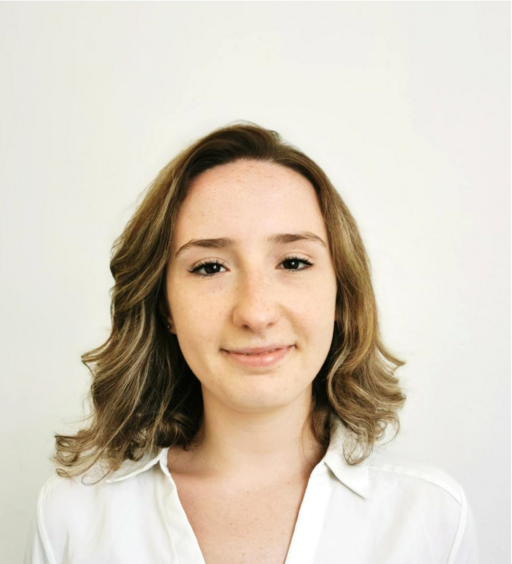
Christiane Huhn
Josef-Schneider-Str. 2
Christiane graduated 2022 with a MSc in Chemistry (1.2) from the Humbold University of Berlin and the Leibniz-Forschungsinstitut für Pharmackologie (FMP).
In the Maric lab she focusses on the development of fluorescent probes for high-end microscopy.
Huhn et al JACS 2025
Huhn et al Methods in Molecular Biology 2025
Bastl, ..., Huhn et al ChemBioChem 2025
Hodson, ..., Huhn et al Researchsquare 2024
Stiegler, ..., Huhn et al Angewandte Chemie 2022
Huhn et al BIOspektrum 2022
Birke, ..., Huhn et al Organic & Biomolecular Chemistry 2022
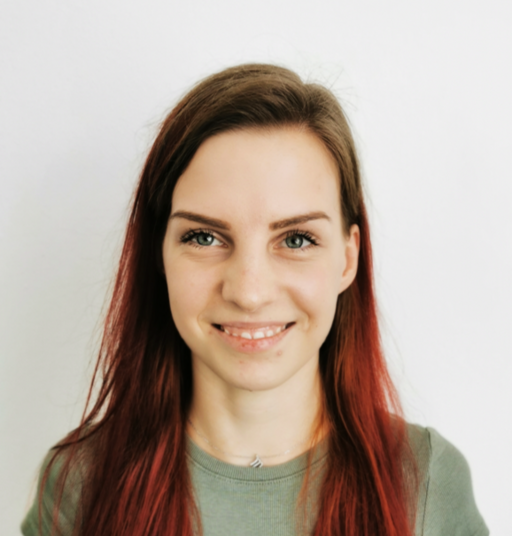
Sonja Kachler
Josef-Schneider-Str. 2
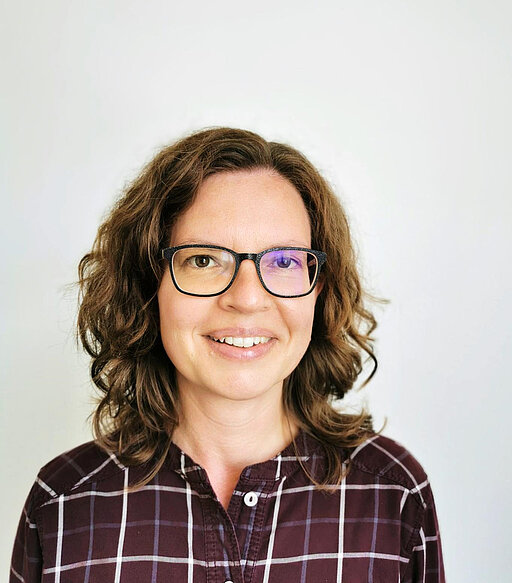
Vladimir Khayenko
Josef-Schneider-Str. 2
Vladimir graduated 2017 with distinction (94.99/100) from The Hebrew University of Jerusalem with a MSc. in Pharmacy and Medicinal Chemistry.
In the Maric lab he focussed on development of activity-based probes and viral capsid aggregators.
Khayenko et al eLife 2024
Jobin, ..., Khayenko et al Nature Communications 2023
Schulte, Khayenko et al Molecular Methods in Microbiology 2022
Khayenko et al Angewandte Chemie 2022
Makbul, Khayenko et al Microorganisms 2021
Khayenko et al BIOspektrum 2021
Schulte, Khayenko et al iScience 2021
Khayenko et al Frontiers in Molecular Neuroscience 2019
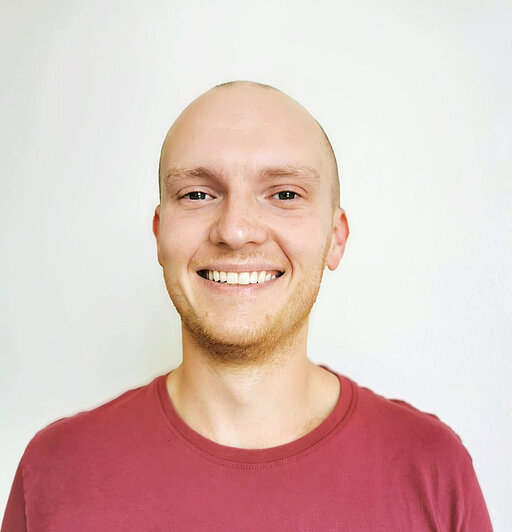
Dr. Hans Maric
Josef-Schneider-Str.2

Clemens Schulte
Josef-Schneider-Str. 2
Clemens graduated with a MSc. in Biochemistry from the Oregon Health and Science University and University of Wuerzburg in 2019.
In the Maric lab he focuses on the profiling and targeting of protein-protein interactions:
Kostrz, Maynard, Schulte et al bioRxiv 2025
Huhn, Ho, Schulte et al JACS 2025
Khayenko, Makbul, Schulte et al eLife 2025
Yeste-Vazquez, ..., Schulte et al Angewandte Chemie 2024
Jessen, …, Schulte et al Oncogene 2024
Xavier da Silva, Schulte et al Cell Death & Disease 2023
Schulte et al Methods in Molecular Biology 2022
Kaufmann, …, Schulte et al Commun Biol 2022
Khayenko, Schulte et al Angewandte Chemie 2022
Schulte et al Commun Biol 2022
Moreno-Y, …, Schulte et al Nature Commun 2021
Schulte et al iScience 2021
Schulte et al STAR protocols 2021
Schulte & Maric Current Opinion in Pharmacology 2021
Gründl, …, Schulte et al PLoS Genetics 2020
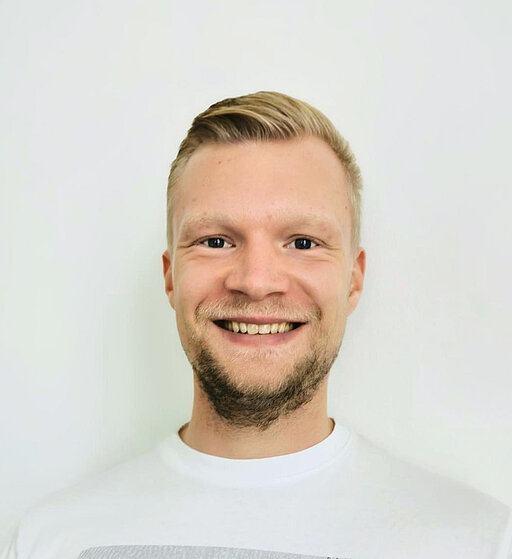
Ivan Talucci
Josef-Schneider-Str. 2
Ivan graduated in 2020 with distinction in Medicinal Chemistry & Pharmaceutical Technologies from the University of Chieti, Italy.
In the Maric, lab he focussed on the decoding of Autoantibodies and Therapeutic Antibodies:
Talucci et al eLife 2025 (in revision)
Huhn, ..., Talucci et al Journal of the American Chemical Society (JACS) 2025
Talucci & Maric Trends in Pharmacological Sciences 2024
Wiessler, Talucci et al Neurology 2024
Kreissner, Faller, Talucci et al Frontiers in Bioinformatics 2024
Talucci, Arlt et al Frontiers in Immunology 2024
Wirts, ..., Talucci et al Neuropathy and applied Neurobiology 2024
Arlt, …, Talucci et al Neurology 2024
Navarro, Talucci et al European Heart Journal 2024
Talucci & Maric Methods in Molecular Biology 2023
Eckes, Talucci et al Neurology, Neuroimmunology & Neuroinflammation, 2023
Bünger, Talucci et al Brain Behaviour and Immunity Health 2023

Omkar Valanju
Josef-Schneider-Str. 2
Omkar obtained a B.Sc. in Pharmacy in Navi Mumbay, India and a M.Sc. in Medicinal Chemistry at the National Institute of Pharmaceutical Education and Research in Nagar Punjab, India. After working as synthetic and computational chemist in the lab of Prof. Prasad Bharatam in Nagar Punjab, India, he joined the Maric lab in 2021 to combine synthetic chemistry with array and proteomic readouts to identify, map and decipher interactions mediated by intrinsically disordered protein regions including RNA interactions:
Uhl, ..., Valanju et al bioRxiv 2024
Papadopoulos, Valanju et al Molecular Cell 2024
Baharatam, Valanju et al Drug Discovery Today 2023

Current position
Since 2021 Emmy Noether Group Leader at the Rudolf Virchow Center of the University of Würzburg
Research Experience
| 2015-2017 | Assistant Professor, Center for Biopharmaceuticals, University of Copenhagen, Denmark |
| 2013-2015 | Postdoctoral Fellow, Lundbeck Trust, Copenhagen, Denmark |
| 2012-2013 | Postdoctoral Fellow, Career Development Fellowship, GSLS Würzburg |
Career
| 2002-2008 | Chemistry (Diplom), JMU Würzburg sehr gut |
| 2012 | Phd, JMU Würzburg, summa cum laude |
| 2013 | Postdoc, JMU Würzburg |
| 2013-2015 | Postdoc, University of Copenhagen, Denmark |
| 2015 | Postdoc, Center for Molecular Neurogenetics, University Hospital Hamburg Eppendorf |
| 2015-2017 | Assistant Professor, Center for Biopharmaceuticals, Denmark |
| 2018-2021 | Junior Group Leader, JMU Würzburg |
| since 2021- | Emmy Noether Group Leader, Rudolf Virchow Center |
Awards and Funding
| 2012 | GSLS Career Development Fellowship |
| 2013 | Lundbeck Foundation Fellowship, Denmark |
| 2015 | Torben og Alice Frimodts Fond, Denmark |
| 2016 | Brødrene Hartmanns Fonds, Denmark |
| 2017 | Hørslev-Fonden, Denmark |
| 2018 | Fonds der chemischen Industrie e.V. |
| 2019 | TRR/SFB 166 Receptor Light |
| 2020 | Anschubförderung, JMU Würzburg |
| since 2018 | Exzellente Ideen Förderung, JMU Würzburg |
| since 2021 | Förderung durch das Interdisziplinäre Zentrum für klinische Forschung Würzburg |
| since 2021 | Emmy Noether Program der DFG |
| since 2023 | DFG Förderung |
Supervisor – Chemistry, Pharmacy, Biochemistry, Biology, Biomedicine, FOKUS Life Science, Medicine, Translational Medicine
Member of the GSLS
FOKUS Life Science Selection Committee Member
Courses and Lectures
Biology: Biophysics and Molecular Biotechnology
Biochemistry: Protein Biophysics
FOKUS Life Sciences: Methods




